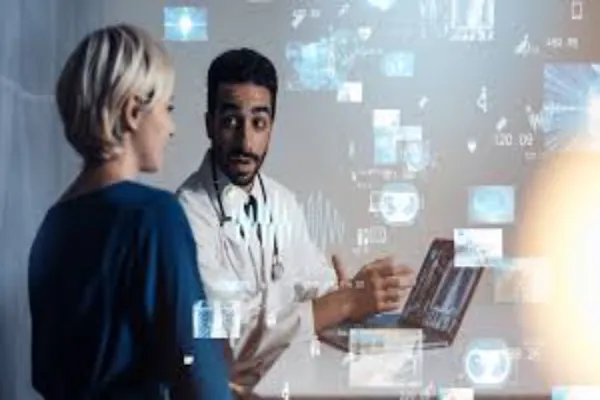How EHRs Are Transforming Clinical Practice

Electronic Health Records (EHRs) have transformed healthcare by reshaping clinical workflows, patient interactions, and care coordination. While they offer opportunities for improved efficiency and population health management, their adoption also brings unique challenges.
Streamlined Documentation and Clinical Workflows
Modern EHR systems have revolutionized clinical documentation, moving beyond simple digitization to create intelligent workflows that support clinical decision-making. Today’s platforms offer structured templates, voice recognition capabilities, and automated data entry that significantly reduce the administrative burden on healthcare providers.
Smart Documentation Features enable clinicians to document patient encounters more efficiently through predictive text, auto-population of routine information, and customizable templates that adapt to different specialties and visit types. These features help providers spend less time typing and more time focusing on patient care.
Integrated Order Entry streamlines the process of ordering medications, tests, and procedures by embedding clinical decision support directly into the ordering workflow. Clinicians receive real-time alerts about drug interactions, dosing recommendations, and evidence-based treatment protocols as they make care decisions.
Real-Time Data Access provides immediate access to comprehensive patient information, including laboratory results, imaging studies, and historical clinical data. This accessibility enables more informed decision-making and reduces delays in care delivery that previously occurred while waiting for paper records or phone calls to retrieve information.
However, these improvements come with learning curves and adaptation challenges. Many clinicians initially experience decreased productivity as they master new documentation methods and adjust their workflow patterns to optimize EHR efficiency.
Enhanced Clinical Decision Support
EHR systems now incorporate sophisticated clinical decision support tools that actively assist providers in making evidence-based care decisions. These capabilities represent a significant departure from passive record-keeping to active clinical guidance that can improve patient outcomes and reduce medical errors.
Predictive Analytics help identify patients at risk for specific conditions or complications before symptoms become apparent. Machine learning algorithms analyze patient data patterns to flag potential issues like sepsis risk, medication adherence problems, or hospital readmission likelihood.
Evidence-Based Alerts provide real-time guidance based on current clinical guidelines and best practices. These alerts can recommend appropriate screening tests, suggest alternative medications based on patient allergies or contraindications, and remind providers about preventive care measures.
Population Health Tools, a type of medical software, enable clinicians to identify and manage patient populations with specific health conditions or risk factors. These tools facilitate proactive outreach, care gap identification, and quality improvement initiatives that extend beyond individual patient encounters.
The challenge lies in balancing helpful guidance with alert fatigue. Clinicians must learn to customize these systems to provide relevant, actionable information without overwhelming them with excessive notifications that can actually impede efficiency.
Improved Care Coordination and Communication
EHR systems have dramatically improved coordination between healthcare providers, specialists, and care teams. Digital platforms enable seamless information sharing and communication that was previously impossible with paper-based systems.
Instant Information Sharing allows multiple providers to access the same patient information simultaneously, eliminating delays and miscommunication that occurred with paper records. Specialists can review primary care notes before consultations, and emergency department physicians can immediately access relevant medical history.
Secure Messaging Systems facilitate rapid communication between healthcare team members without compromising patient privacy. Providers can consult with colleagues, request urgent consultations, and coordinate care plans through secure digital channels.
Care Team Coordination features enable comprehensive care planning involving multiple disciplines and specialties. Nurses, physicians, social workers, and other healthcare professionals can contribute to shared care plans and track progress toward treatment goals.
Patient Portal Integration connects patients directly to their healthcare teams through secure digital platforms. Patients can access test results, communicate with providers, request prescription refills, and participate more actively in their care management.
These communication improvements require new skills and etiquette for digital collaboration. Clinicians must learn to manage digital communications effectively while maintaining personal connections with patients and colleagues.
Data-Driven Quality Improvement
Modern EHR systems generate unprecedented amounts of clinical data that enable continuous quality improvement and performance measurement. This capability transforms healthcare from intuition-based practice to evidence-driven care delivery.
Quality Metrics Tracking provides real-time feedback on clinical performance indicators such as preventive care rates, chronic disease management outcomes, and patient satisfaction scores. Clinicians can monitor their performance and identify areas for improvement.
Outcome Analysis enables providers to analyze treatment effectiveness and patient outcomes across different patient populations. This information supports clinical research, quality improvement initiatives, and evidence-based practice development.
Benchmarking Capabilities allow healthcare organizations to compare their performance against national standards and peer institutions. This comparison drives competitive improvement and identifies best practices that can be replicated.
Research Integration facilitates clinical research by providing standardized data collection and analysis capabilities. Providers can participate in research studies more easily and contribute to medical knowledge advancement.
The abundance of data creates new responsibilities for clinicians to understand and act upon performance metrics while maintaining focus on individual patient care needs.
Patient Engagement and Shared Decision-Making
EHR systems have transformed patient-provider relationships by increasing transparency and enabling more collaborative care approaches. Patients now have unprecedented access to their health information and can participate more actively in care decisions.
Transparent Health Records give patients immediate access to test results, clinical notes, and treatment plans through patient portals. This transparency builds trust and enables patients to become more engaged in their healthcare.
Educational Resources Integration provides patients with condition-specific information and educational materials directly through EHR systems. Providers can prescribe relevant educational content and track patient engagement with health information.
Shared Care Planning enables collaborative development of treatment plans that incorporate patient preferences, goals, and lifestyle considerations. Digital tools facilitate discussions about treatment options and help document shared decisions.
Remote Monitoring Capabilities allow patients to share health data from home monitoring devices, wearable technology, and mobile applications. This information enables more personalized care and early intervention when health status changes.
These capabilities require clinicians to develop new skills in digital communication and shared decision-making while adapting to more informed and engaged patients.
Addressing Implementation Challenges
While EHR systems offer significant benefits, successful adoption requires addressing common implementation challenges that can derail clinical effectiveness. Understanding these pitfalls helps clinicians and healthcare organizations navigate transitions more successfully.
Many healthcare organizations experience difficulties during EHR transitions due to inadequate readiness assessment, poor system selection decisions, and weak project leadership. Up to 60% of EHR implementations fail to meet their intended goals, often leaving organizations with frustrated staff and disrupted workflows.
Change Management represents a critical success factor that many organizations underestimate. EHR adoption requires fundamental changes in documentation habits, decision-making processes, and collaboration methods that can be challenging for clinical staff.
Training and Support must extend beyond initial system orientation to include ongoing education about new features, workflow optimization, and best practices. Many organizations underestimate the support resources needed during transition periods.
Data Migration challenges can result in lost information, data integrity problems, and significant operational disruptions if not properly planned and executed.
Successful EHR adoption requires systematic planning, comprehensive preparation, and ongoing commitment to optimization and improvement. Healthcare organizations that invest adequate time and resources in readiness assessment, team building, and staff preparation achieve better outcomes with less disruption.
The Future of Clinical Practice
EHR systems continue evolving rapidly, incorporating artificial intelligence, machine learning, and advanced analytics that will further transform clinical practice. These emerging capabilities promise even greater support for clinical decision-making and patient care coordination.
Artificial Intelligence Integration will provide more sophisticated clinical decision support, predictive analytics, and automated documentation capabilities. AI-powered tools may help identify patterns in patient data that human providers might miss.
Interoperability Improvements will enable seamless data exchange between different healthcare systems, creating more comprehensive patient records and supporting care coordination across organizational boundaries.
Mobile and Cloud Technologies will provide greater flexibility in how and where clinicians access patient information, supporting telehealth initiatives and remote care delivery models.
Patient-Generated Data Integration will incorporate information from wearable devices, mobile health applications, and home monitoring systems to create more complete pictures of patient health status.
Conclusion
The adoption of EHR systems offers healthcare providers opportunities to enhance efficiency and patient care but requires ongoing adaptation and skill development. Clinicians should view EHRs as tools to complement clinical judgment and patient relationships.




